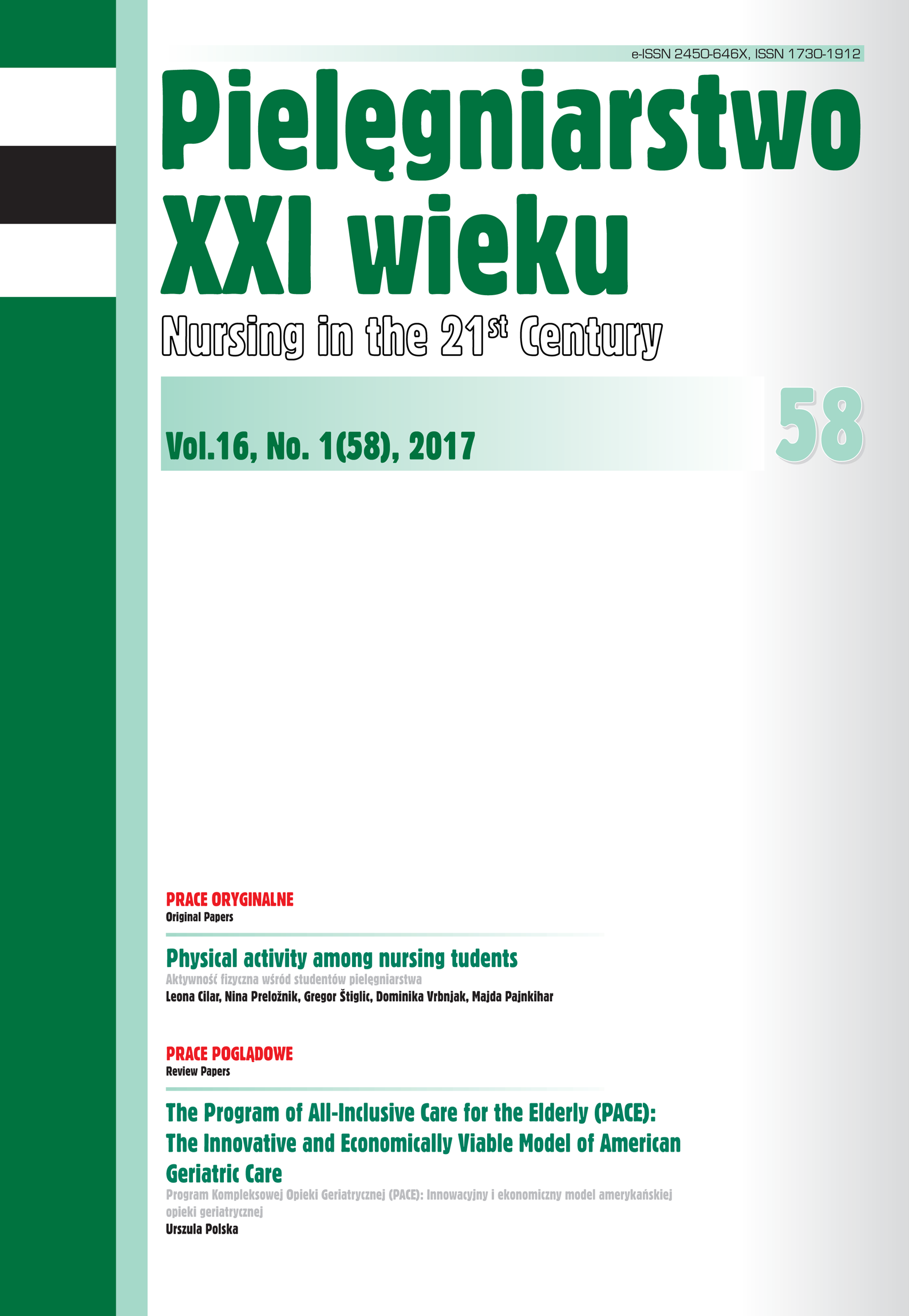Występowanie syndromu wypalenia zawodowego w praktyce pielęgniarki
DOI:
https://doi.org/10.1515/pielxxiw-2017-0002Słowa kluczowe:
syndrom wypalenia zawodowego, pielęgniarka, badanieAbstrakt
WYSTĘPOWANIE SYNDROMU WYPALENIA ZAWODOWEGO W PRAKTYCE PIELĘGNIARKI
Wprowadzenie. Syndrom wypalenia zawodowego w znaczącym stopniu wiąże się z zawodem pielęgniarki. U osób zmagających się z nim, pojawiają się istotne problemy zdrowotne. Konieczne jest pogłębianie wiedzy dotyczącej częstości występowania oraz czynników ryzyka wypalenia zawodowego, aby możliwe było jego zapobieganie oraz ustalanie leczenia w przypadku gdy się pojawi.
Cel pracy. Celem badania jest identyfikacja występowania syndromu wypalenia zawodowego w zawodzie pielęgniarki, porównanie jego występowania w zależności od typu oddziału oraz zbadanie wpływu cech demograficznych na jego powstawanie.
Materiał i metody. W części empirycznej opisano metodę pracy, analizy danych, ich opracowanie oraz badania statystyczne. Do zebrania potrzebnych informacji użyto standaryzowanego Kwestionariusza Wypalenia Zawodowego (Burnout Measure, BM). Uzyskane dane przedstawiono w wykresach.
Wyniki. Wynikiem badania jest odkrycie, że występowanie syndromu wypalenia zawodowego w zawodzie pielęgniarki jest znaczące, jednak nie zaobserwowano istotnych różnic pomiędzy różnymi miejscami pracy. Analizy statystyczne pokazały wpływ czynników demograficznych na występowanie syndromu wypalenia zawodowego. Statystycznie istotnymi cechami były wiek badanych i długość ich praktyki.
Wnioski. W oparciu o wyniki badania, można stwierdzić, iż konieczne jest wzmocnienie przeciwdziałania wypaleniu zawodowemu wśród pielęgniarek. Występowanie syndromu zostało potwierdzone w niniejszym badaniu. Średnia wartość indeksów BM dla wszystkich badanych pielęgniarek wynosiła 3.40, zaś indeks BM dla pielęgniarek z grupy A wyniósł 3.44, natomiast z grupy B 3.36. Te średnie wartości jasno pokazują, iż znajdują się one w obszarze „obecności oznak wypalenia”. W tej kategorii indeksu BM występują istotne oznaki wypalenia, jednak nie jest to jeszcze rozwinięty syndrom wypalenia zawodowego. Niepokojące okazało się odkrycie, iż trzy pielęgniarki z grupy B znalazły się w przedziale 5 indeksu BM, co oznacza stan alarmowy, wymagający szukania profesjonalnej pomocy.
Bibliografia
1. Palfi I, et al. The role of burnout among Hungarian nurces. International of Nurcing Practice. 2008,14 (1):19-25.
2. Gandi J, et al. The role of stress and level of bernout in job performance amonge nurces, Mental health in family medicine. 2011, 8(3): 181-194. Citované dňa: [15.12.2013]. Dostupné na: http://www.hebi.nlm.nih.gou/pms/articles/PMCB3314275/
3. Barling J, Taylor B. Identifying sources and effects of career fatigue and burnout for mental health nurses: A qualitative approach. International Journal of Mental Health Nursing. 2004, (13): 117-125.
4. Halm M, et al. Hospital nurse staffing and patient mortality, emotional exhaustion, and job dissatifaction, Clinical Nurse Specialist. 2005, (19): 241-251.
5. Adams R, et al. Compassion fatigue and psychological distress among social workers: A validation study. American Journal of Orthopsychiatry. 2006, (76): 103-108.
6. Kebza V, Šolcová I. Syndrom vyhoření. Praha: Statní zdravotní ústav. 2003, p. 245.
7. Křivohlavý J. Sestra a stres – příručka pro duševní pohodu. Praha: Grada. 2010, p.76.
8. Golembiewski R, et al. Estimates of burnout in public agencies: Worldwide how many employees have vhich degrees of burnout, and with what consequences? Public Administration Review. 1998 (58): 59-65.
9. Kovářová M, Hanzlíková A. Fyzické a psychické nároky práce operačných sestier v kontexte NEXT štúdie. In: Revue ošetrovateľstva a laboratórnych metodík. 2005,11(1): 6-10.
10. Hudáková A, et al. Prevencia stresu u sestier pracujúcich v intenzívnej starostlivosti. In: Zdravotníctvo a sociálna práca. 2011, 6(3-4):90-91.
11. Simočková V. Syndróm vyhorenia. In: Žiaková, K. eds.,Ošetrovateľský slovník. Martin: Osveta. 2009, p.245.
Opublikowane
Numer
Dział
Licencja
Prawa autorskie (c) 2017 Autorzy

Praca jest udostępniana na licencji Creative Commons Attribution-NonCommercial-NoDerivatives 3.0 Unported License.




